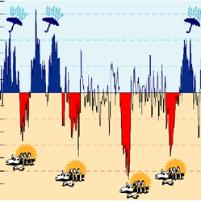All Queensland sectors face downturns due to dry heat
Published on 18 September, 2003
Policy makers and industry planners need to act to avert the gradual economic and social downturns as dryer and hotter conditions are expected to continue.
That is according to a presentation to this week's Sustainable Economic Growth in Regional Australia (SEGRA) conference on the Gold Coast. (Sept 16, 2003).
Professor Bob Miles, from Central Queensland University's Institute of Sustainable Regional Development, said the eastern seaboard (particularly Queensland) faced significant downturns in all sectors unless planners came to terms with climatic trends.
 (Dr Miles' presentation was co-authored by Dr Roger Stone, Director of the Queensland Centre for Climate Applications in the Queensland Department of Primary Industries.) Professor Miles said research by the International Panel on Climate Change (IPCC) and others suggests the trend to drier conditions is likely to continue as the El Nino like mean conditions prevail.
(Dr Miles' presentation was co-authored by Dr Roger Stone, Director of the Queensland Centre for Climate Applications in the Queensland Department of Primary Industries.) Professor Miles said research by the International Panel on Climate Change (IPCC) and others suggests the trend to drier conditions is likely to continue as the El Nino like mean conditions prevail.
Professor Miles said drier, hotter conditions will effect all of our daily lives including: .
our cropping and grazing industries; .
heavy industry and multinational investment; .
health of the elderly; .
tourism and the reef; .
viability of rural urban communities; .
the spread of viral disorders such as Ross River virus; .
the cost of water treatment due to blue green algae; .
as well as energy demands for cooling, pest problems, land values and forest fire incidents.
"One of the concerns is that much of our existing infrastructure was built around a data set based on a higher rainfall period and may not adequately reflect the current and emerging risk margins," he said.
"Australia is already recognised as one of the driest continents on earth and parts of Queensland have the highest recorded climate variability in the world ... in particular in the eastern seaboard around the tropic of Capricorn." "We need more detailed research, risk management and contingency planning by government and the community at all levels." .
Professor Miles said a recent Central Queensland community leaders workshop identified a number of local examples of climatic effects, including: .
* water shortages for the industrial sector at Gladstone, placing at risk investment in the heavy industrial estate; .
* water shortages in the Fairburn Dam at Emerald, posing a risk to the viability of the entire Emerald irrigation area; .
* a Western Downs solutions group (in Chincilla) has realised that after 10 years of failed crops there is a need to seek alternatives; .
 * the grazing sector in Paroo River is drought declared eight years in 10; .
* the grazing sector in Paroo River is drought declared eight years in 10; .
* the cropping industry in the Central Highlands of Queensland has shifted to pulse crops such as mung beans and chick peas after years of failed summer and winter crops.
Ironically, the eastern seaboard is facing hotter and drier conditions at a time when there is an increase in average rainfall down the Western Australian interior, due to changes in cyclonic activity in El Nino years. ENDS For details/interview call Professor Bob Miles via 0408 766 569 or 07 4930 9053 or via b.miles@cqu.edu.au .
Caption for graphic: The Central Queensland coast has experienced a gradual and progressive decline in rainfall over the past 100 years, as shown by the 20-year running mean rainfall at Rockhampton during the 1890-2003 period. In this example, the rainfall recorded by the Australian Bureau of Meteorology has been smoothed using a 20-year moving average to compress short-term variability and highlight the longer-term trend.

